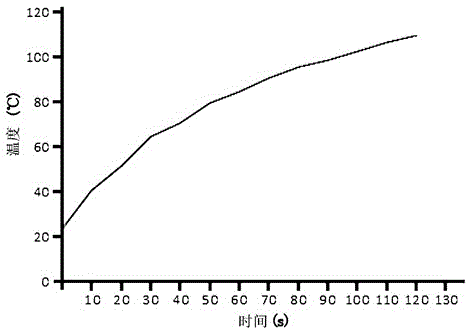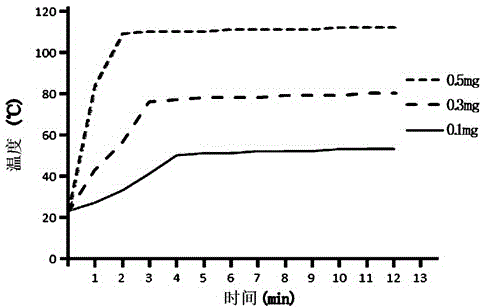A method for bone cement to subsequently generate heat
A bone cement and follow-up technology, applied in medical science, prosthesis and other directions, can solve the problems of poor treatment effect, lower polymerization heat temperature, and unsatisfactory release effect, so as to improve long-term efficacy and good biocompatibility. Effect
- Summary
- Abstract
- Description
- Claims
- Application Information
AI Technical Summary
Problems solved by technology
Method used
Image
Examples
Embodiment 1
[0025] Group 1: Acrylic resin bone cement powder 20g and 0.5mg gold nanorods are fully stirred and mixed, 10ml of liquid material is added, and fully stirred until the late stage of drawing or the early stage of the dough, injected into a cylindrical mold with a diameter of 1.5cm, and the test temperature range is inserted 0~200℃ thermometer.
[0026] Group 2: Another 20g of acrylic resin bone cement powder is directly added to 10ml of acrylic resin bone cement liquid material, then injected into a cylindrical mold with a diameter of 1.5 cm, and inserted into a thermometer with a test temperature range of 0 to 200°C.
[0027] Record the temperature changes of the two separately, see for specific results figure 1 . The results show that there is no difference between bone cement and ordinary bone cement added with gold nanorods, and gold nanorods have no effect on the heat release of bone cement polymerization.
Embodiment 2
[0028] Example 2: In vitro temperature release of gold nanorods of different concentrations
[0029] Mix 20g of acrylic resin bone cement powder with 0.1mg~0.6mg gold nanorods to form a mixture; pour 10ml of acrylic resin bone cement liquid into the above mixture, fully stir until the drawing period or the early stage of the dough, the injection diameter is A 1.5cm cylindrical mold is formed, and a thermometer with a test temperature range of 0~200℃ is inserted; after the acrylic resin bone cement is cured for 24 hours, it is irradiated with infrared rays, and the wavelength of the infrared rays is 550nm~1550nm. The diameter of the gold nanorods is 10-40nm and the length is 30nm-100nm. figure 2 The energy of surface infrared light can be converted into heat by nano-gold, which increases the heat temperature of bone cement polymerization.
Embodiment 3
[0030] Example 3: The mechanical strength of different concentrations of gold nanorods and ordinary bone cement
[0031] Acrylic resin bone cement powder 20g is mixed with 0.1mg, 0.3mg and 0.5mg gold nanorods respectively, and 10ml acrylic resin bone cement powder is added, and it is fully stirred until the late stage of drawing or the early stage of dough, and the injection diameter is 1.5cm cylinder The shaped mold is formed, and a thermometer with a test temperature range of 0~200℃ is inserted. After curing the acrylic resin bone cement for 24 hours, irradiate the infrared laser generator and the acrylic resin bone cement block at a distance of 15cm. The temperature of the three changes can be seen image 3 . The results show that the rate and degree of temperature increase of acrylic resin bone cement are closely related to the amount of gold nanorods added. .
PUM
| Property | Measurement | Unit |
|---|---|---|
| wavelength | aaaaa | aaaaa |
| diameter | aaaaa | aaaaa |
| length | aaaaa | aaaaa |
Abstract
Description
Claims
Application Information
 Login to View More
Login to View More - R&D
- Intellectual Property
- Life Sciences
- Materials
- Tech Scout
- Unparalleled Data Quality
- Higher Quality Content
- 60% Fewer Hallucinations
Browse by: Latest US Patents, China's latest patents, Technical Efficacy Thesaurus, Application Domain, Technology Topic, Popular Technical Reports.
© 2025 PatSnap. All rights reserved.Legal|Privacy policy|Modern Slavery Act Transparency Statement|Sitemap|About US| Contact US: help@patsnap.com



